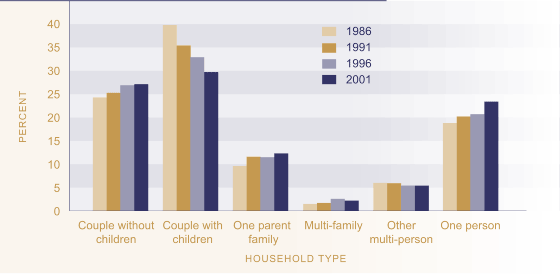A household may contain a single person living alone, or two or more people who usually live together and share facilities, either as families (couples, parents with children), or groups of individuals flatting together. There were 1.3 million households in New Zealand in 2001, an increase of 23 percent over the number recorded in 1986.
Twenty-seven percent of households contained couples without children in 2001, 30 percent contained two-parent families with children, 12 percent were one-parent family households, two percent contained more than one family, five percent comprised a group of individuals, and 23 percent were one-person households.
Figure P4 Distribution of households,
by household type, 1986-2001

Source: Statistics New Zealand
Couple-only and one-person households are the fastest growing household types and are projected to increase the most over the next 15 years. Population ageing is the major factor behind both of these changes. But declining fertility and the closing gap between male and female life expectancy are also contributing to the rising number of couples without children, while delayed marriage, divorce and changing lifestyle preferences are contributing to the growing number of one-person households.
